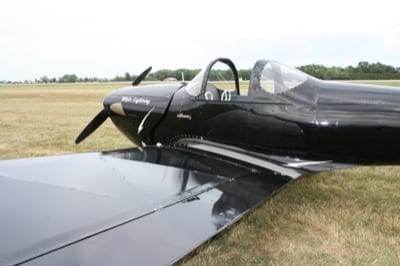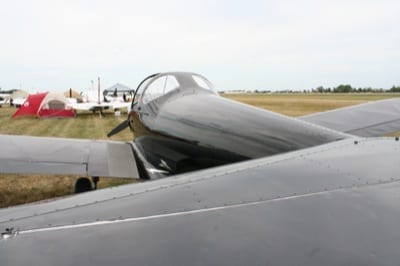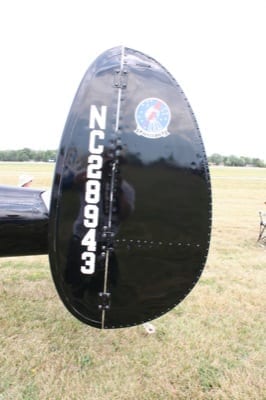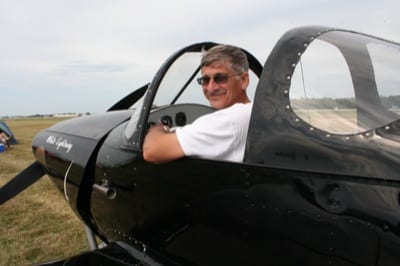Polished metal, blue, green, yellow, red — these are the colors I’m used to seeing on Ercoupes. So it was downright exciting to find a solid black Ercoupe parked in the vintage display area of this year’s AirVenture, with the name “White Lightning” emblazoned on the side of the cowling.
 “The color wouldn’t have been my first choice,” said the airplane’s owner, Kevin Gassert of Cincinnati, Ohio, gesturing to the black-with-white-trim aircraft. “The previous owner painted it that color and it has kind of grown on me. If you look in the antique area it’s not unusual to see a black pre-war airplane and it’s too good of a paint job to strip off.”
“The color wouldn’t have been my first choice,” said the airplane’s owner, Kevin Gassert of Cincinnati, Ohio, gesturing to the black-with-white-trim aircraft. “The previous owner painted it that color and it has kind of grown on me. If you look in the antique area it’s not unusual to see a black pre-war airplane and it’s too good of a paint job to strip off.”
Gassert isn’t sure about the origin of the name, but he appreciates its whimsy on an airframe known in some circles as “The old man’s airplane.”
 The distinctive paint job makes the Ercoupe hard to miss at any aviation event, said Gassert, noting that several people came up to him during AirVenture to say that they were happy to see the airplane flying again.
The distinctive paint job makes the Ercoupe hard to miss at any aviation event, said Gassert, noting that several people came up to him during AirVenture to say that they were happy to see the airplane flying again.
“When I got the airplane, it had been idle for several years and was in pretty sorry condition,” he said. “It was a pile of parts.”
A BIT OF HISTORY
The Ercoupe, designed in 1939 by Fred Weick, has two dominant features: The twin-boom tail and an absence of rudder pedals. Like most airframes of that era, the Ercoupe ceased production during World War II, then picked up again at the end of the war. The Ercoupe became one of the many post-war orphaned airplanes. But you can’t keep a good design down. In the post-war years, the airplane was built by Erco Aircraft Co., Forney Aircraft, and, finally, Mooney.
 Gassert’s airplane is a 1941 Erco, manufactured Jan. 28, 1941, serial number 38.
Gassert’s airplane is a 1941 Erco, manufactured Jan. 28, 1941, serial number 38.
“It is one of 110 Ercoupes that were made before the war,” he said, noting it is a 415-C model with a 65-hp engine. “It doesn’t have an electrical system or rudder pedals,” he added, noting that the plane is light enough to qualify as a Light-Sport Aircraft because it meets the weight restriction of 1,320 pounds.
“I fly it as a private pilot,” said Gassert. “I got my private pilot’s license in 1975. I have about 875 hours now and half of that in Ercoupes.”
 The restoration of White Lightning took longer than Gassert thought it would.
The restoration of White Lightning took longer than Gassert thought it would.
“I had hoped to have it fly to Oshkosh 2011, but the airplane wasn’t ready yet,” he said, noting that was due to the fact that there are subtle structural differences between post-war and pre-war airframes.
“The 1941 Ercoupe looks like the post-war Ercoupes, but very few of the parts interchange,” he explained. “For example, the seat-back and the cockpit is an inch narrower than the post-war models. Another difference is that a lot of the rivet holes on the tail are different places. They are just different enough they don’t fit. It also has a different braking system from the later models. These are things you don’t think about until you have to start putting things together.”
The flight from Cincinnati to this year’s Big Show was the White Lightning’s first big trip after the post-Gassert restoration.
“It gained airworthy status just a week or so ago,” Gassert explained. He was especially honored when he was asked to park his airplane in front of the Vintage Headquarters for an afternoon.
“A lot of people in the Ercoupe community know the airplane and were happy to see it flying again and make it to Oshkosh,” he said with pride. “A lot of non Ercoupers also seemed to like it. We spent all day Monday in front of the Vintage Red Barn as the featured type club aircraft talking to folks.”
 White Lightning isn’t Gassert’s first Ercoupe and it won’t be his last.
White Lightning isn’t Gassert’s first Ercoupe and it won’t be his last.
“I have another Ercoupe, in pieces,” he laughed. “This is my ‘have fun’ airplane until I get that one finished.”
